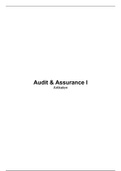Samenvatting
Samenvatting Audit & Assurance I - Artikelen
- Instelling
- Rijksuniversiteit Groningen (RuG)
Dit document bevat alle artikelen die op de literatuurlijst staan. Zie ook de inhoudsopgave op de eerste pagina. Ik heb alle artikelen achter elkaar geplakt en daarin gemarkeerd wat belangrijk is en hier en daar opmerkingen geplaatst. Voor ieder artikel heb ik een pagina opgenomen met een korte sam...
[Meer zien]




